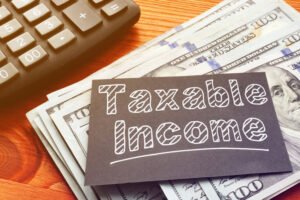Yes, it’s entirely possible to make more than $100,000 and pay no federal income tax on it. This little trick is completely legal and — incredibly! — the tax code almost seems to encourage you to use it.
Even if you don’t qualify for this strategy, you still have many ways to drastically reduce your tax liability.
Let’s start with the premise that you can take home $126,700 free of federal income taxes. The thing is, you can make a fair bit more than that and still not pay income taxes, but we’ll stick with the basics for now and then later show how you can flex your earning potential and still avoid income taxes.
To take advantage of this strategy, you’ll be using two key elements:
- The tax rate on long-term capital gains and qualified dividends
- The standard deduction on your income taxes
The big thing to know, however, is that you can recognize as much as $96,700 in qualified investment income as a married couple and pay no federal income tax. Tack on another $30,000 in income that is tax-free from a standard deduction, and you can escape income tax on at least $126,700.
Let’s break these elements down and show you how they add up to paying no federal income tax.
Capital gains: 0 percent tax rate on long-term investment income
The tax rate on investment income — from long-term capital gains and qualified dividends — is a huge part of how you get to avoid taxation on a large income. The tax code has a (mostly forgotten) special 0 percent rate for those earning less than certain amounts of taxable income (your adjusted gross income minus your deduction, either standard or itemized).
Tax rates for long-term capital gains and qualified dividends for 2025
| Filing status | 0% tax rate | 15% tax rate | 20% tax rate |
|---|---|---|---|
| Single | Up to $48,350 | $48,351 to $533,400 | Over $533,400 |
| Married filing separately | Up to $48,350 | $48,351 to $300,000 | Over $300,000 |
| Head of household | Up to $64,750 | $64,751 to $566,700 | Over $566,700 |
| Married filing jointly | Up to $96,700 | $96,701 to $600,050 | Over $600,050 |
If you’re married filing jointly, you fall into the 0 percent bracket if your taxable income is less than $96,700 in 2025. If you file as an individual, you’ll need to earn $48,350 or less to take advantage of the special bracket.
You’ll want to be careful that your investment income meets the requirements for qualified dividends and long-term capital gains, however.
- Long-term capital gains include profits from selling securities that you’ve held for more than a year. If you buy and sell in less than a year, you pay at ordinary income rates.
- To be a qualified dividend, the dividend must be paid by a U.S. corporation or a qualified foreign company, such as one trading on a U.S. exchange. The stock must have been held for more than 60 days in the 121-day period that begins 60 days before the stock’s ex-dividend date for common stock. For preferred stock, the dividend is qualified if you hold it for more than 90 days in the 181-day period that begins 90 days before the ex-dividend date. Finally, the stock must not otherwise be excluded. Some dividends, such as those issued by real estate investment trusts (REITs) or master limited partnerships, do not qualify for the special tax treatment, and payouts are treated as ordinary income.
That’s a lot of verbiage, but the upshot is that most dividends qualify, and if you’re practicing a buy-and-hold strategy with some of the top long-term investments, then the holding requirements are basically a non-issue.
If there’s a catch, it’s this: Every dollar of taxable ordinary income that you earn eliminates a dollar of this investment income that could be subject to no taxes. If wages from a job, for example, exceed the 0 percent level of taxable income, your long-term capital gains and qualified dividends will bump up to a 15 or even 20 percent tax rate, if you earn enough. That’s where the standard (or itemized) deduction comes in, reducing your ordinary income as much as possible.
Standard deduction: The easy way to lower your taxable income
The second key part of the strategy here is to take full advantage of your standard deduction. By way of the deduction, all taxpayers get the first portion of their income tax-free. And that amount depends on your tax filing status: single, married filing jointly and others.
| Filing status | 2025 standard deduction |
|---|---|
| Single | $15,000 |
| Married filing separately | $15,000 |
| Head of household | $22,500 |
| Married filing jointly | $30,000 |
| Qualifying widow or widower | $30,000 |
The standard deduction can reduce any kind of income, such as investment income or earned income (that is, money from a job).
It’s worth noting, however, that if you earn any income from labor (not investments), then you still must pay payroll taxes. Payroll taxes cover things such as Social Security and Medicare. As an employee, you’re on the hook for a tax of 6.2 percent for Social Security (up to a certain income threshold) and a further 1.45 percent for Medicare (with no income cap). If you’re self-employed or a contractor, those percentages are doubled because you pay the employer’s side too. So while you can avoid income taxes, you won’t be able to escape payroll taxes on earned income.
Add up the $30,000 standard deduction and the $96,700 of protected investment income, and a married couple could make $126,700 and not pay a dime of federal income taxes. Even single filers could claim $63,350 tax-free using the same strategy. Those thresholds that the IRS sets tend to rise with time, too.
Using this strategy, of course, you’ll want to be extremely careful that you stick to the rules and don’t exceed the income levels. Your tax advisor can help you make smart decisions here, too.
5 more ways to get tax-free income
Making $126,700 in tax-free income sounds great. So while we’re at it, let’s cover a few more ways that you can increase your income and still not pay income taxes. A married couple could easily earn tens of thousands of dollars more and still use this strategy.
Using the same plan as above, you can pile on even more income tax-free, if you do it strategically. The key to remember is that your taxable income must stay below the key thresholds. That means you have two more levers to pull — adjustments to income and deductions — to work the tax code in your favor.
Here are five more strategies that you can use to get even more tax-free income:
- 1. Take full advantage of 401(k) or 403(b) plans.
-
An employer’s retirement plan such as a traditional 401(k) or traditional 403(b) is one of the easiest and most impactful ways to reduce your taxable income. You can contribute as much as $23,500 on a pre-tax basis in 2025, and a spouse could add the same amount, allowing you to reduce your taxable income by as much as $47,000 annually. Plus, many companies provide an employer match, offering you free money to save for retirement.
- 3. Contribute to a health savings account.
-
A health savings account (HSA) is one of the adjustments on your tax return that helps reduce your taxable income. An HSA offers a triple tax advantage, including reducing your taxable income today, up to $4,300 for individuals and $8,550 for families if you have a qualifying health plan.
- 4. Itemize your deductions.
-
While the standard deduction offers a fixed dollar amount that reduces your taxable income, you may be able to deduct more if you have expenses such as mortgage interest, state and local taxes and charitable contributions, among many others. The amount could vary depending on the level of your expenses here.
- 5. Use tax-loss harvesting.
-
With tax-loss harvesting, you can use losses to offset any amount of capital gains, dollar for dollar, and then write off a loss of up to $3,000 annually from your income — even rolling past losses forward into future years. That’s useful if your income is too high for comfort at year-end. Conveniently, many of the best online brokers offer automatic tax-loss harvesting at no cost.
These are just a few of the more powerful ways to reduce your taxable income by claiming all the adjustments and deductions that you’re entitled to and otherwise optimizing your income. There are dozens of other adjustments and deductions that can impact your taxable income.
For example, you can contribute to a traditional IRA if you’re working, but your income must be under a certain threshold, or it won’t be tax-deductible. For those with an employer’s retirement plan, that level is just $126,000 in modified adjusted gross income if you’re married filing jointly in 2025. That’s another $7,000 per person tax-free, if you’re under age 50, or $8,000, if older.
Upshot: Starting from the baseline of $126,000, a married couple under age 50 could add on another $55,550 in tax-free income by maxing out an employer’s retirement plan and an HSA alone. If you itemize deductions, it’s possible to get an incremental $20,000 or more from that deduction, pushing a couple’s total tax-free income toward $200,000.
Of course, maxing out your tax-free income with this strategy begins with having assets that produce long-term capital gains and qualified dividends — in other words, stocks and stock funds — allowing you to recognize investment income at a 0 percent rate. You then use this income to contribute more to retirement accounts from earned income and pay for living expenses.
Even if you don’t have that level of assets to work with, however, you can still take advantage of many of these tax-saving adjustments and deductions to reduce your taxable income.
Bottom line
It’s possible to make more than $100,000 and pay no federal income taxes, but it’s easier to do if you start with some assets already. The tax code privileges income from investments over income from work, but you can still make the tax code work for you even without being a trust fund baby.
Editorial Disclaimer: All investors are advised to conduct their own independent research into investment strategies before making an investment decision. In addition, investors are advised that past investment product performance is no guarantee of future price appreciation.
Why we ask for feedback
Your feedback helps us improve our content and services. It takes less than a minute to
complete.
Your responses are anonymous and will only be used for improving our website.
Help us improve our content
Read the full article here

















